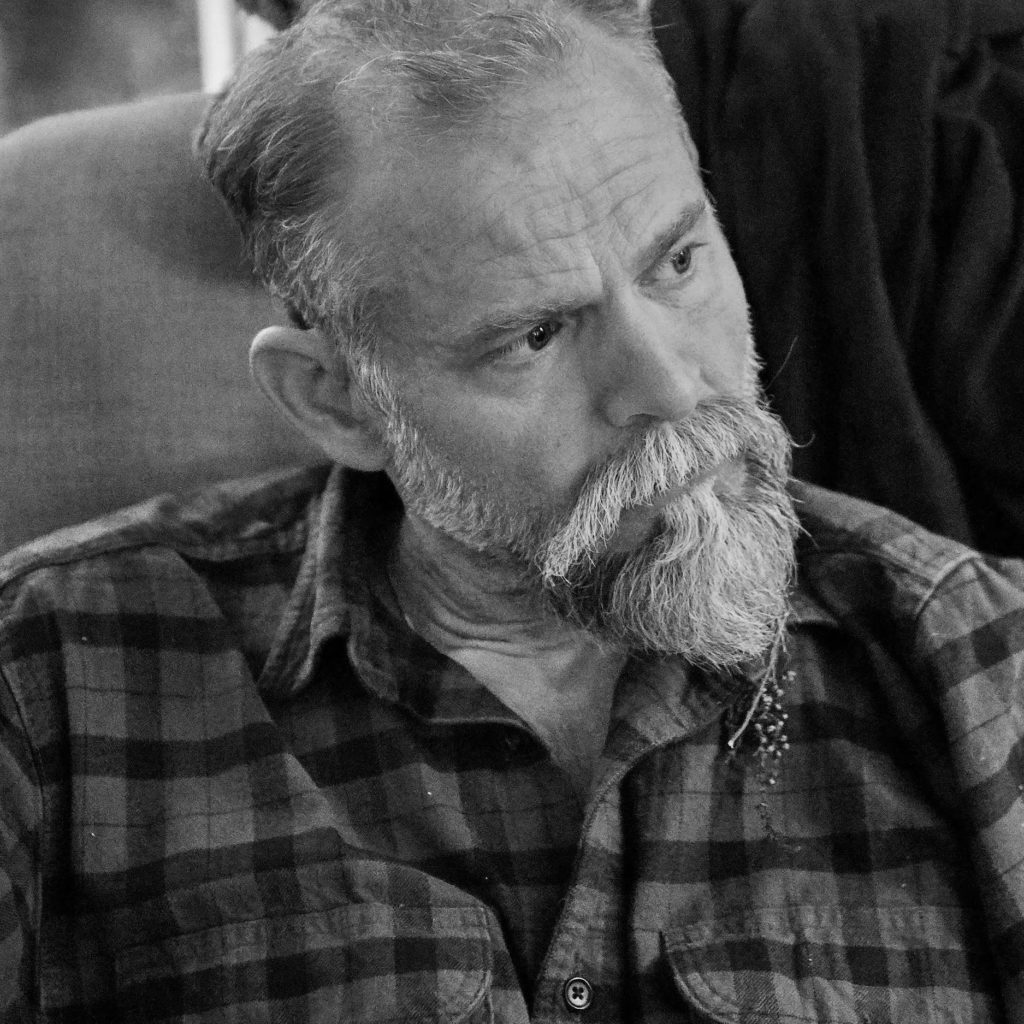The Audience

Damon: Well, gosh, what do you think about audience?

Charlie: Audience is tricky. I talk a lot about finding a “third thing” in a project—that element that bends the text and concept into uncharted terrain. The third thing is all about creating indeterminacy. It has to be difficult to predict; impossible is better. When I staged Waiting for Godot against the train tracks in Spokane a couple years back, the BNSF railroad served that purpose. The actors and I had to figure out how to respond to the train, and no published schedule exists. There they are waiting for Godot, and an oil train rolls by, less than 20 feet behind the stage, with an engineer who blows the horn and waves. Well, the actors have to respond to something like that, and that response either makes or breaks the performance. I like that. When you and I created Now at the Uncertain Hour, one third thing in that process was the collision of Camilla Ammirati‘s fretless banjo and Wes Kline‘s modular synthesizer. We didn’t know exactly where that would take the project. But you asked me about audience. At its best and when they’re given an ability to respond, the audience is always the most formidable third thing I can imagine, but that assumes an active audience.
Since Laura, I’ve tried to create in a way that compels the audience to complete the creative process. I’ve overused the Anne Michaels quote by now, but it makes the point: “not two to make one, / but two to make / the third, / just as a conversation can become / the third side of the page.” Think of it. It’s easy to manipulate people. It’s far more difficult to create so that an audience of 100 leave with 100 individual responses that they’ve claimed for themselves. Nevertheless, a lot of people just want to receive a performance. I get that. Laura requires more effort than a lot of film audiences are used to, but that was the experiment. I’ll be interested to see how audiences respond to that piece in December when we open it as a gallery installation. An audience’s expectations are specific to each form. I’m curious about what happens when those forms collide or overlap.

Mostly, I find that theatre artists spend far too much time thinking about the audience, or at least how to please and attract them. Theatre and performance are often one more thing to be bought and sold. Ask a theatremaker how the show went after opening night, and you’re likely to hear about ticket sales first. Still, as Virginia Woolf said, “No audience. No echo. That’s part of one’s death.” I find that our friends and collaborators from the visual arts don’t think of the audience much, if at all. That’s not the tradition in the visual arts nor is it the expectation of gallery goers. The same goes for the folks we’ve worked with who come from European traditions. Is our preoccupation with audience an American thing? Disregard them and you’re alone with your work. Think too much about them and you’re selling tchotchkes to tourists. How do you walk that line as a writer? Do you think more about audience when you’re writing for film and theatre than when you’re writing other forms?
Damon: If a person is writing and wants to publish or create a performance or screen a film or submit at all, then that person wants an audience. Yet it should be obvious that wanting an audience and thinking about an audience are different puzzles. And I’ll say it straight. I don’t think about an audience when I begin to write something new. Doesn’t matter what I am writing either—a play, a poem, or an essay. Now, that’s not to say I don’t think about audience at any point. But for me, audience is a late consideration.
Late consideration though it may be, I recognize that audience and form share a relationship. For instance, I recently wrote an essay for the Canyon Country Zephyr in which I discuss meeting Jim Stiles, the publisher of the Zephyr, as a young man. I write about growing up in Moab, Utah, and how the town has changed. The Zephyr has a wide audience, most of whom I will guess are familiar with Moab and the canyon country, many of whom are familiar with Jim and his years spent writing about the Southwest. Given these things, I can write an essay with a certain confidence that Zephyr readers know the publication, and to this extent, I know the readers of the Zephyr. There’s nothing fancy about that. Even so, any consideration of how my writing may touch one reader or another comes late.

You see, there must be a need to write something before I can write anything. It is a curious need and at times, a selfish one. But there must be some struggle of the heart. Faulkner said it. He said we cannot forget “the problems of the human heart in conflict with itself, which alone can make good writing because only that is worth writing about, worth the agony and the sweat.” Or, as Jim Croce says, “I’ll have to say I love you in a song.” Someone may ask, Does there really need to be agony to write an essay for the Zephyr? My answer is this—you’re damn right there needs to be agony. That initial struggle happens within and privately, and profoundly so, and not with an audience. In The Scent of a Thousand Rains there’s enough agony to fill a room, and maybe an audience will experience some of that. Yet an audience doesn’t need to feel my struggle. They need to feel the struggle of the character in the poem. More personally, if I had not written that poem, if I had not said what I needed to say, then some part of my heart would have been left in devastating silence.
Still, it’s remarkable to me how different the approach of a writer and a director might be, and yet, somehow, we largely want the same things.
Charlie: Wanting an audience and thinking about an audience are different puzzles, as you say, but they’re both hardwired into the work of a director. Take a novel out of the hands of a reader, and the book exists just fine on the shelf. I guess you could make an argument that the writing loses its key essence of being, but the work remains complete. The same goes for film. Take the audience away from the theatre, and you’re left with a rehearsal. Now, the best performances I’ve ever seen have happened in the rehearsal studio, but concessions must be made to edit a piece for the public.
Brecht wanted his audiences to be like those at a boxing match. Now, that’s completing the creative act! I like an audience to be active but not quite participatory. An audience is distinct, in that way, from a congregation. I hold to Peter Brook’s definition: “I can take any empty space and call it a bare stage. A man walks across an empty space whilst someone else is watching him, and this is all that is needed for an act of theatre to be engaged.” Space, actor, observing audience. Take any one of those out and you’re left with something just shy of the form. With apologies to our decade-plus writer/director collaboration, note that he leaves the writer out in the cold.

The audience is fundamental, but our audience is fractured. When I think about audience, I see a moving target. Who are they? Why have they come? What do they want? Lean in to any one of these questions during the process of creation, and you lose the agony—that personal struggle you described—that is essential. Those questions are the realm of the producer, and as you’ve heard me say before, the producer and the director are obliged to alternate their work, even if we’re talking about the same individual. I can’t do both at once. Herbert Blau writes, “…where performance and commerce meet there is still a perceptible unity, an audience that echoes its edification through all the changes of fashion—theory of value and acting method inscribed with the price of the ticket, along with standards of credibility.” Roughly put: audiences eat what they’re served and demand more of the same. How many revivals of Oklahoma! can one audience sustain? Plenty. Samuel Johnson famously wrote for the opening of London’s Drury Lane Theatre in 1747, “The stage but echoes back the public voice. / The drama’s laws the drama’s patrons give, / For we that live to please, must please to live.” The problem I see is that Blau and Johnson—one critical, one enabling—both sell the audience short. As we say in our mission statement at Square Top, we trust that our audience members are intelligent, curious, sensitive, and engaged. Surely there’s more to observing “the drama’s laws” than being a short order cook. Why do we continue staging Romeo & Juliet, as I will again in the fall? As you responded once before, “we want to have our hearts broken again.” Well, that means figuring out how to frame things so that an audience might see and see it again.
Damon: I would hope so, but then we can learn a lot from Oklahoma! or Romeo & Juliet. I’ll happily let the heart suffer over many a Broadway story and tune. If there is a tearless way out of “Send in the Clowns,” I won’t take it.
Photographs © Rebekah Wilkins-Pepiton
Writer Damon Falke & Director Charles M Pepiton have been creating and producing work together for theatre and film since 2008.
